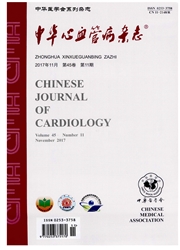

 中文摘要:
中文摘要:
目的 采用钆对比剂延迟增强(LGE)心脏磁共振成像(CMR)评价冠心病患者慢性完全闭塞病变(CTO)的心肌活性,并观察CTO病变侧支循环与存活心肌之间的关系.方法 回顾性分析2015年9月至2016年6月首都医科大学附属北京安贞医院心内科由侵入性冠状动脉造影检查确诊的40例CTO患者,所有患者均在1周内进行CMR检查.采用Rentrop分级评价CTO病变血管的侧支循环,根据Rentrop分级将侧支循环分为轻度或无侧支循环组、中度侧支循环组和良好侧支循环组.根据CMR影像对心肌节段的延迟强化透壁程度进行评分,对心肌节段的室壁运动进行分级,并计算室壁运动积分指数(WMSI),采用Spearman相关性分析心肌延迟强化透壁程度与WMSI之间的关系.结果 轻度或无侧支循环组6个心肌区域,其中1个心肌区域具有存活心肌,5个心肌区域无存活心肌;中度侧支循环组16个心肌区域,其中11个心肌区域具有存活心肌,5个心肌区域无存活心肌;良好侧支循环组24个心肌区域,其中21个心肌区域具有存活心肌,3个心肌区域无存活心肌;各组间差异有统计学意义(P =0.002).轻度或无侧支循环组、中度侧支循环组和良好侧支循环组的WMSI分别为1.54±0.50、1.21±0.34和1.26±0.40,各组间差异无统计学意义(P=0.063).Spearman相关性分析显示,心肌延迟强化透壁程度的增加与WMSI相关(r=0.638,P〈0.01).结论 慢性完全闭塞病变患者的侧支循环可预测心肌活性,随着Rentrop等级的增加具有存活心肌的可能性更大.
 英文摘要:
英文摘要:
Objective Late gadolinium enhancement (LGE) cardiac magnetic resonance imaging (CMR) was used to evaluate the myocardial viability of chronic total occlusion (CTO) in patients with coronary heart disease and to observe the relationship between collateral circulation and myocardium viability in these patients.Methods This retrospective study included 40 patients with CTO diagnosed by invasive coronary angiography (CAG) from September 2015 to June 2016 in our department,all patients performed CMR examination within one week after CAG.The collateral circulation of CTO was graded with Rentrop classification as follows:poor or no collateral circulation group,moderate collateral circulation group and good collateral circulation group.According to CMR images,the delayed enhancement transmural extent of myocardial segments were scored,the ventricular wall motion of the myocardial segment were graded,and the wall motion score index (WMSI) was calculated.Spearman correlation analysis was used to analyze the relationship between the delayed enhancement transmural extent of myocardial segments and WMSI.Results In the no or poor collateral group of 6 myocardial regions,1 myocardial region had viable myocardium and 3 myocardial regions had no viable myocardium;in the moderate collateral group of 16 myocardial regions,11 myocardial regions had viable myocardium and 5 myocardial regions had no viable myocardium;in the good collateral group of 24 myocardial regions,21 myocardial regions had viable myocardium and 3 myocardial regions had no viable myocardium,there was significant difference between the groups (P =0.002).The WMSI of poor or no collateral circulation group,moderate collateral circulation group and good collateral circulation group were 1.54 ± 0.50,1.21 ± 0.34 and 1.26 ± 0.40,respectively,there was no significant difference between the groups (P =0.063).Spearman correlation analysis showed that the extent of delayed enhancement transmural extent of myocardial segment was significantly
 同期刊论文项目
同期刊论文项目
 同项目期刊论文
同项目期刊论文
 期刊信息
期刊信息
